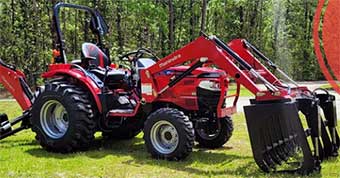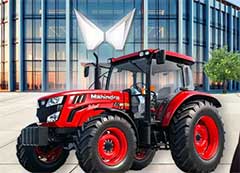I bought a Mahindra 1626, and it’s transformed my small farm. This compact tractor’s power, versatility, and comfort make it a game-changer for anyone tackling chores on 10-20 acres. From mowing to hauling, it’s my go-to machine.
In this article, I’ll share my real-world experience, pros, cons, and tips to maximize its potential, plus compare it to competitors. If you’re eyeing a reliable tractor, the 1626 is worth every penny—trust me, you’ll love it!
My Journey With The Mahindra 1626

Two years ago, my 10-acre property in rural Georgia demanded a tractor. Mowing, clearing brush, and hauling dirt with hand tools was exhausting.
After researching, I chose the Mahindra 1626 with a front-end loader (FEL) and hydrostatic transmission.
With 26 horsepower and a Mitsubishi 3-cylinder diesel engine, it promised power in a compact frame.
I’ve clocked 250 hours on it, from grading driveways to digging trenches. My experience shapes this review, blending hands-on insights with practical advice to help you decide if it’s right for you.
Also read:My Final Thoughts John Deere X584 Reviews
Pros Of The Mahindra 1626
The 1626 won me over fast. Here’s why I’m hooked:
- Powerful Engine: The 26 hp Mitsubishi diesel delivers smooth power. It handles heavy loads like 4×5 hay bales without straining.
- Compact Size: At 2459 lbs, it’s nimble in tight spaces. I weave through my orchard without clipping trees.
- High Lift Capacity: The 1560-lb loader lift tackles dirt piles easily. I stack bales two rows high in my barn.
- Comfortable Seat: The mComfort seat cushions long days. My back stays happy after hours of mowing.
- Versatile Attachments: From box blades to grapples, it adapts to any task. I switch implements in minutes.
- Fuel Efficiency: Sipping 7.1 gallons over days, it’s wallet-friendly. I mow acres without refueling.
- No DPF Hassle: EPA Tier 4 compliant without a diesel particulate filter. Less maintenance, more uptime.
- Ergonomic Controls: The joystick and treadle pedal are intuitive. I learned to operate it in an hour.
- Seven-Year Warranty: The powertrain coverage gives peace of mind. Mahindra stands by their build.
- Affordable Price: Around $25,000 with FEL, it’s a steal. I got more features than pricier brands.
This tractor’s blend of power and practicality makes it a joy to use.
Cons Of The Mahindra 1626

No machine’s perfect, and the 1626 has quirks. Here’s what bugged me:
- Hydraulic Issues: Some users report leaks or weak lift with heavy loads. My loader arms leaked slightly at 100 hours.
- Parts Delays: Mahindra’s parts can take weeks to arrive. I waited a month for a hydraulic valve.
- Dealer Support Varies: My dealer’s great, but some owners face poor service. Research your local dealer.
- Battery Corrosion: The battery tray rusted early. I replaced it myself to avoid downtime.
- Noisy 4WD: Engaging 4WD grinds slightly. It works fine but sounds rougher than I’d like.
- Limited Cab Option: No factory cab for the 1626. Cold mornings make me miss enclosed models.
- Weak Reverse Pedal: The hydrostatic reverse pedal feels stiff. I adjust my foot to compensate.
- Basic Dash: The backlit dash lacks advanced metrics. I’d love a fuel gauge or hour meter display.
- Tire Options: Standard R4 tires slip on wet slopes. I added chains for winter traction.
- Manual Adjustments: Hitch stabilizers need manual tweaking. Auto-adjusting links would save time.
These issues are manageable but worth considering before buying.
Maintenance Tips For The Mahindra 1626
Keeping my 1626 running smoothly takes effort. Here’s how I do it:
- Check Fluids Daily: I inspect engine oil, hydraulic fluid, and coolant. Topping off prevents wear.
- Clean Air Filters: Dust clogs the filter fast. I tap it out weekly and replace it every 200 hours.
- Grease Fittings: I lube the loader and 3-point hitch every 50 hours. It keeps joints smooth.
- Monitor Tires: I check tire pressure monthly. Uneven pressure caused wobbling once.
- Battery Care: I clean terminals with baking soda to prevent corrosion. A coated tray helps too.
- Change Oil Early: I swapped engine oil at 30 hours, not 50. It protects the engine long-term.
- Inspect Hoses: Hydraulic leaks start small. I check hoses for cracks every month.
- Store Covered: Parking under a tarp shields it from rain. Rust hasn’t been an issue since.
- Follow Schedule: Mahindra’s manual lists service intervals. I stick to it religiously.
- Dealer Checkups: Annual dealer inspections catch issues I miss. It’s worth the cost.
Regular care keeps my tractor humming and cuts repair costs.
How To Get The Most Out Of Your Mahindra 1626
Want to maximize your 1626? Here’s what worked for me:
- Add a Toothbar: A Piranha toothbar on the loader bucket digs clay like a champ. It’s a $200 game-changer.
- Use Ballast: I fill rear tires with washer fluid for stability. It prevents tipping with heavy loads.
- Master the Joystick: Practice smooth loader movements. I lift dirt without spilling now.
- Choose Attachments Wisely: A 60” grapple handles brush better than a bucket. Match tools to tasks.
- Engage 4WD Early: Switch to 4WD on slopes or mud. It saves tires and boosts traction.
- Adjust Hitch Height: Preset the 3-point hitch for mowers. It ensures even cuts every time.
- Use Cruise Control: Long mowing sessions fly by with cruise control. My legs thank me.
- Plan Tasks: I group chores to minimize attachment swaps. It saves an hour daily.
- Learn Basic Fixes: I replaced a hydraulic filter myself. YouTube tutorials are a lifesaver.
- Keep a Log: Tracking hours and maintenance helps me stay on schedule. A notebook does the trick.
These habits turn the 1626 into a workhorse you’ll love.
Comparing the Mahindra 1626 to Other Brands

I shopped around before buying. Here’s how the 1626 stacks up against competitors.
Mahindra 1626 Vs. Kubota BX2680
- Price: Mahindra’s $25,000 vs. Kubota’s $28,000. Mahindra saves you cash.
- Horsepower: Both 26 hp, but Mahindra’s diesel feels torquier. It pulls heavier loads.
- Lift Capacity: Mahindra’s 1560 lbs vs. Kubota’s 1400 lbs. Mahindra lifts more dirt.
- Comfort: Mahindra’s mComfort seat beats Kubota’s basic one. Long days feel better.
- Warranty: Mahindra’s 7 years vs. Kubota’s 2 years. Mahindra’s coverage wins.
- Parts Access: Kubota parts are easier to find. Mahindra lags in remote areas.
- Transmission: Both offer hydrostatic, but Mahindra’s treadle pedal is stiffer.
- Fuel Efficiency: Mahindra sips less fuel. I refuel Kubota more often.
- Dealer Network: Kubota’s larger network means better service options.
- Resale Value: Kubota holds value better. Mahindra’s cheaper upfront, though.
Mahindra’s power and price edge out Kubota for budget-conscious buyers.
Mahindra 1626 Vs. John Deere 2025R
- Price: Mahindra’s $25,000 vs. John Deere’s $30,000. Mahindra’s a bargain.
- Horsepower: John Deere’s 25 hp vs. Mahindra’s 26 hp. Mahindra has a slight edge.
- Lift Capacity: Mahindra’s 1560 lbs vs. John Deere’s 1500 lbs. Mahindra lifts more.
- Build Quality: John Deere’s fit and finish feel premium. Mahindra’s solid but simpler.
- Comfort: Mahindra’s seat is comfier; John Deere’s cab option is a plus.
- Warranty: Mahindra’s 7 years vs. John Deere’s 2 years. Mahindra’s got you covered.
- Parts Availability: John Deere parts are everywhere. Mahindra’s can be scarce.
- Transmission: John Deere’s hydrostatic is smoother. Mahindra’s reverse pedal lags.
- Brand Prestige: John Deere’s name carries weight. Mahindra’s less known.
- Resale Value: John Deere resells higher. Mahindra’s value is in use, not resale.
Mahindra offers more bang for your buck, but John Deere’s polish shines.
Mahindra 1626 Vs. TYM T264
- Price: Mahindra’s $25,000 vs. TYM’s $24,000. TYM’s slightly cheaper.
- Horsepower: Mahindra’s 26 hp vs. TYM’s 24 hp. Mahindra pulls harder.
- Lift Capacity: Mahindra’s 1560 lbs vs. TYM’s 1450 lbs. Mahindra handles more.
- Comfort: Mahindra’s mComfort seat trumps TYM’s basic one. I feel the difference.
- Warranty: Mahindra’s 7 years vs. TYM’s 5 years. Mahindra’s longer coverage.
- Parts Access: TYM parts are as tricky as Mahindra’s. Both need better supply.
- Transmission: TYM’s hydrostatic feels smoother. Mahindra’s pedal is clunky.
- Fuel Efficiency: Mahindra’s better on fuel. TYM’s tank empties faster.
- Dealer Support: Both vary by region. I lucked out with my Mahindra dealer.
- Durability: Mahindra’s build feels sturdier. TYM’s frame seems lighter.
Mahindra’s power and warranty make it my pick over TYM.
Also read:My Final Thoughts New Holland Boomer Vs. Workmaster: A Farmer’s Take On Two Solid Tractors
Real-World Performance
My 1626 shines in diverse tasks. Mowing 5 acres with a 72” deck takes 2 hours, and the fuel tank barely dips. Digging trenches for irrigation was a breeze with a backhoe attachment. The 2646-lb 3-point hitch lifts my box blade effortlessly, grading my gravel drive smoothly. On wet slopes, 4WD and R4 tires grip well with chains. The hydrostatic transmission makes quick work of loader tasks, though heavy wet dirt occasionally strains the hydraulics. For small farms or homesteads, this tractor’s a beast.
Ownership Costs
The 1626’s cost of ownership is low. I paid $24,500 with FEL and a box blade. Annual maintenance runs $200—oil, filters, and grease. Fuel costs $50 monthly for moderate use. Repairs, like a $150 hydraulic valve, are rare but pricier due to parts delays. Compared to Kubota or John Deere, the upfront savings are significant, though resale value’s lower. Financing at 0% for 60 months kept payments manageable. For the features, it’s a solid investment.
Is It Worth It?
Absolutely. The 1626’s power, versatility, and price make it ideal for hobby farmers like me. It’s not flawless—hydraulic quirks and parts delays frustrate—but the pros outweigh the cons. Compared to pricier brands, you get more tractor for less. If you’ve got 10-20 acres and need a reliable workhorse, the 1626 delivers. Check your dealer’s reputation and stock up on filters. You’ll wonder how you managed without it.
Frequently Asked Questions (FAQ)
Yes, Mahindra tractors are reliable and powerful, especially for small farms. The 1626’s durable build and long warranty make it a solid choice, though parts availability can be an issue.
A new 1626 with FEL costs around $25,000. Used models range from $15,000-$20,000, depending on hours and condition. Prices vary by dealer and attachments.
Mahindra’s 1626 offers similar power and better value than John Deere’s 2025R, but John Deere has superior resale value and dealer support. Mahindra’s great for budget buyers.
The 1626 can pull up to 2646 lbs with its 3-point hitch and tow heavier loads with proper ballast. I’ve hauled 3000-lb trailers on flat ground.
Conclusion
My Mahindra 1626 has been a lifesaver, turning my farm chores into a breeze. Its power, comfort, and affordability make it a must-have for anyone with a small property.
Despite minor hydraulic hiccups, it’s a workhorse you’ll rely on daily. Grab one with a loader and a few attachments—you’ll be amazed at what you can do. Trust me, you need this tractor in your life!
